Three-fingered sloths (Bradypus)
There are 4 living species of three-fingered sloths, all of which live within the forests of Central and South America where the tropical climate maintains relatively warm temperatures all year round.
The 4 species include:
- Brown-throated sloth (Bradypus variegatus)
- Pygmy sloth (Bradypus pygmaeus)
- Pale throated sloth (Bradypus tridactylus)
- Maned sloth (Bradypus torquatus)
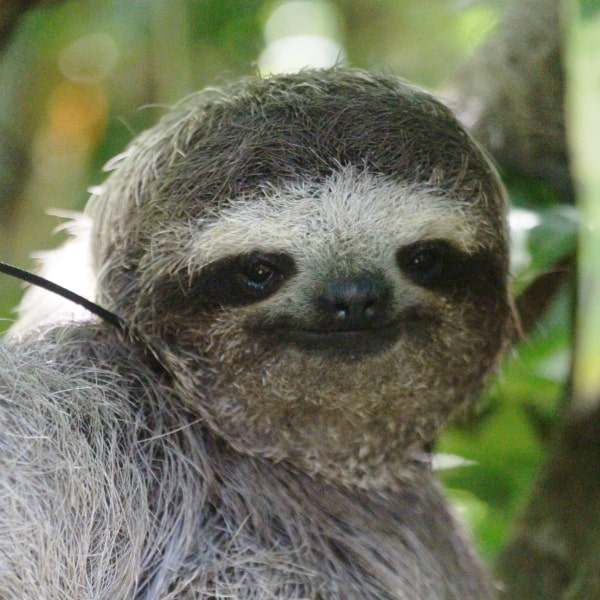
1. Features
- All four species have small round heads with small ears and a permanent smile.
- Three of the four species have a characteristic dark mask around the eyes (the maned sloths are the exception to this).
- They have short, stubby tails 6-7 cm long (about 2.5 inches) which they use when pooping, and three very long fingers at the end of each limb.
- Three-fingered sloths have very long arms– twice as long as their legs! This allows them to reach across gaps in the forest canopy and forage for the young, tender leaves that grow on the outer tips of branches. Sloths prefer to eat these because they are easier to digest and often have lower toxin contents than other leaves.
- Three-fingered sloths have fewer ribs than two-fingered, but they have extra neck vertebrae. Almost all other mammals have seven cervical neck vertebrae, but three-fingered sloths have nine. This extra-long neck gives three-fingered sloths the unusual ability to rotate their head 270°, as much as an owl can. This looks quite strange, but it allows sloths to effectively scan for danger while only moving their heads.
2. Distribution and phylogeny

3. Three-fingered sloth species
3.1 Brown-throated sloth (Bradypus variegatus)
- Conservation status: Least concern
The brown-throated sloth is probably the most well-known of all the sloths. They can weigh between 2.3 and 6.5kg and are approximately 40-69cm (16 to 27 inches) from nose to tail.
They have grey/brown and white coloring with a white forehead. Distribution ranges from Honduras all the way down to Peru and Bolivia, co-existing in some areas with the Hoffmann’s two-fingered sloth.
The life expectancy is currently unknown due to the difficulties of keeping these sloths in captivity, but it is estimated to be more than 30 years. The oldest brown-throated sloth in captivity lived for 27 years at the Sloth Sanctuary of Costa Rica. They are often confused with the pale-throated sloth.

3.2 Pygmy sloth (Bradypus pygmaeus)
- Conservation status: Critically endangered
The very rare pygmy sloths are found exclusively on the tiny and remote Isla Escudo de Veraguas in Panama, which separated off from the mainland approximately 9000 years ago.
They were first identified as a new species in 2001. Pygmy sloths are approximately 40% smaller than their mainland counterparts and although the population size remains unknown, these little sloths are one of the most critically endangered mammals in the world. They average around 3 kg (6.5 lbs) in weight and are approximately 60 cm (2 feet) long.
They look very similar to the brown-throated sloth. Pygmy sloths are thought to live in and feed primarily from the red mangroves which surround the island, but have also been known to live on the edges of the interior forest.

3.3 Pale-throated sloth (Bradypus tridactylus)
- Conservation status: Least concern
Pale-throated sloths live in the rainforests of northern South America, ranging from French Guiana to Suriname and Colombia.
They are of similar size and weight to the brown-throated sloth; however, they boast a large bright yellow face, white throat, and mottled fur. Like other three-fingered sloths, they have just five teeth on their upper jaw and four on their lower jaw which is small and rounded. There is very little research into the biology or ecology of this species.
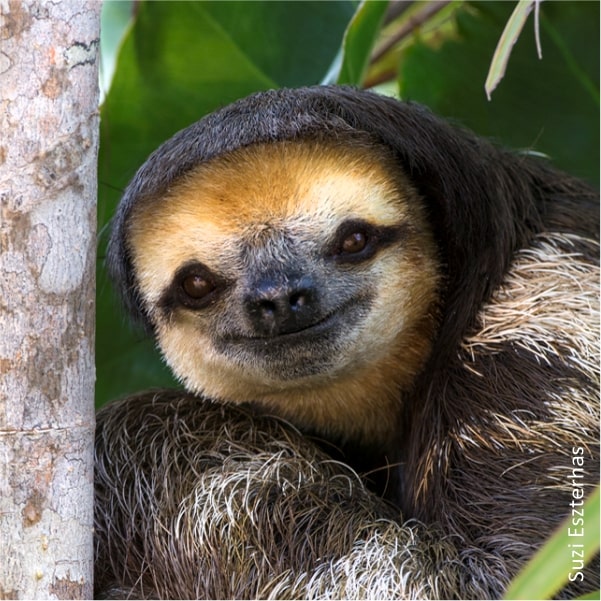
3.4 Maned sloth (Bradypus torquatus)
- Conservation status: Vulnerable
The rare maned sloth is only found in the Atlantic coastal forest of Brazil. Maned sloths are pale brown to grey and are so named due to the presence of a distinctive mane of black hair on the neck.
The mane is usually larger and darker in males, perhaps because they do not develop the bright orange markings (called the speculum) as seen in males of other three-fingered sloths. They can grow up to 75 cm (30 inches) in length and nearly 10 kg in weight – making them the largest of the three-fingered sloths.
The biggest threat to the maned sloth is habitat loss, however, they are sometimes threatened by poachers for food and the pet trade.
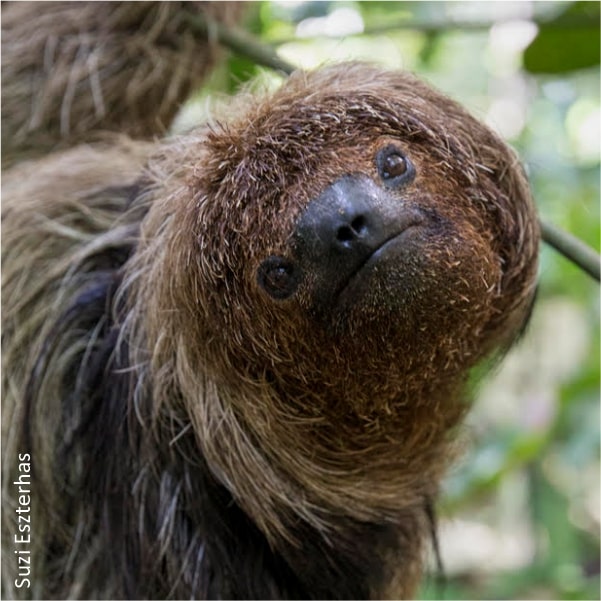
4. Mating and reproduction
4.1 Estrus cycle
Although the exact estrus cycle is unknown, it is thought that three-fingered sloths go in to heat for 7-10 days every month. During this time the female will emit a high-pitched vocalization to signal her readiness to mate.
There is some debate as to the presence of a mating season in three-fingered sloths, although this appears to be limited to regions that experience extreme seasonal change.
Male sloths are strongly polygamous and will fight to exclude competing males from their territory.
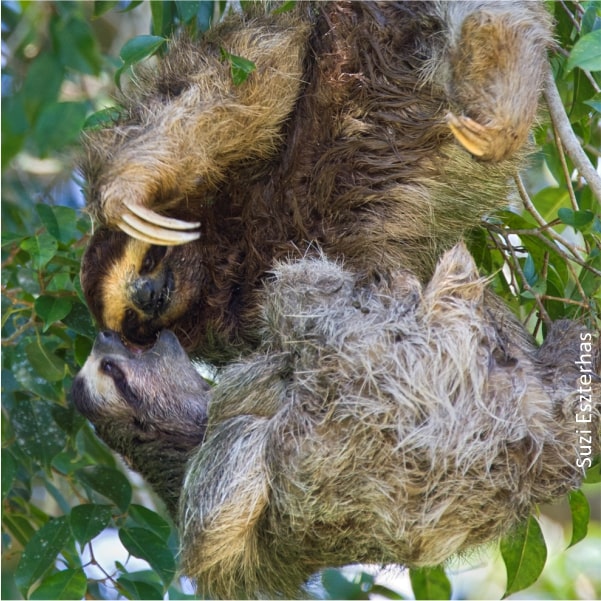
4.2 The Male Speculum
All adult male three-fingered sloths except the maned sloths have a brightly colored patch of fur on their upper back called a speculum.
The speculum is always yellow or orange with a black stripe down the center and has additional markings in a pattern unique to each sloth.
The hair in this patch is short and downy, covered in an oily secretion, and has a musty scent. Because sloths do not have external genitalia, the presence of a speculum is the only easy way to distinguish males from females.
The speculum only develops at sexual maturity, which happens at 1 – 2 years old for three-fingered sloths.
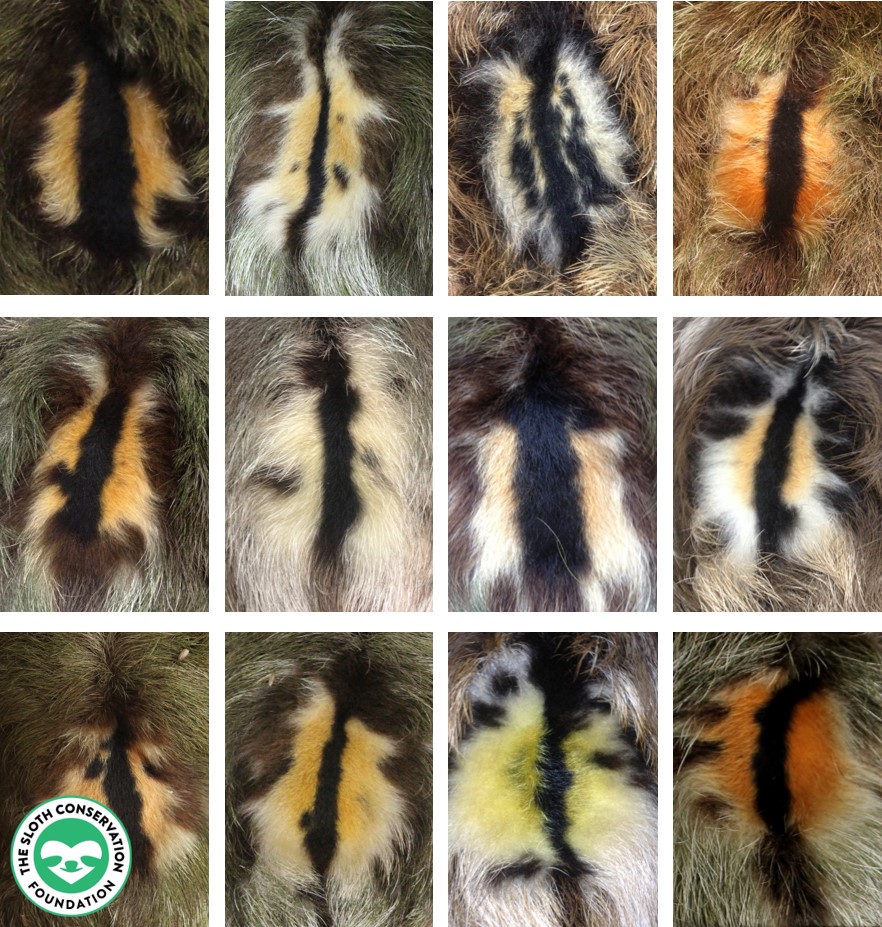
4.3 Gestation
Female three-fingered sloths give birth (hanging upside down) to a single young after a gestation period estimated to be between 6-12 months.
The baby is born ready to face the world, with fully formed teeth, eyes open and a strong instinct to cling onto the mother’s fur.
They do sometimes fall, but sloths are incredibly resilient and have been known to survive a drop of over 90 feet!
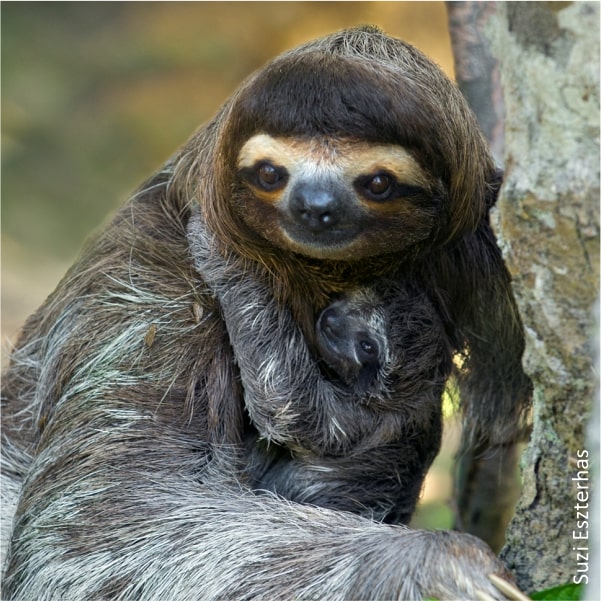
4.4 Three-fingered baby sloths
A baby sloth is thought to stay with the mother for a full 12 months, during which time it learns all of the essential skills required to survive in the wild. As well as drinking milk, the baby will begin to sample leaves from around the mother’s mouth from as early as 1 week old.
This process teaches the offspring exactly which tree species are safe to eat. Following the weaning process, the mother leaves her territory to her young and establishes herself elsewhere.

5. Sloth Hair and Sloth Moths
Three-fingered sloth’s hair is specially adapted to facilitate the growth of symbiotic algae and fungi. Each hair has a unique groove running along the length of the shaft which traps moisture. The algae and fungi that grow make the sloth appear green which facilitates camouflage in the rainforest canopy.
Some species of fungi living in sloth fur have even been found to be active against certain strains of bacteria, cancer, and parasites! Alongside hosting algae and fungi, sloth hair also provides a home to an entire ecosystem of invertebrates – some species of which are found nowhere else on earth! A single sloth can host up to 950 moths and beetles within its fur.
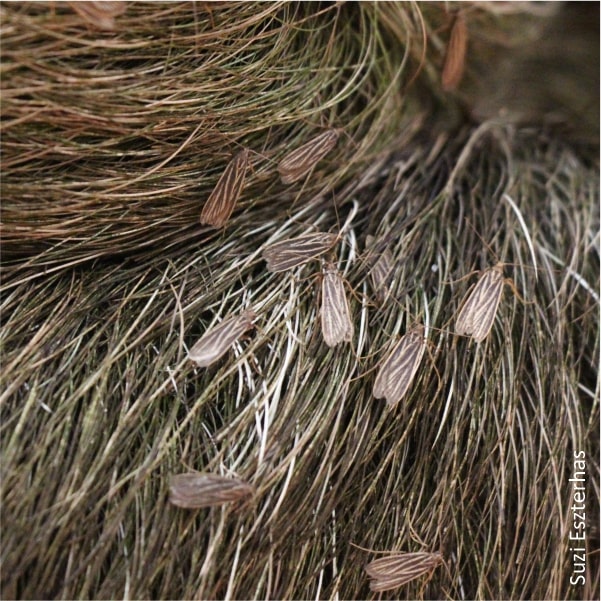
6. Diet
All three-fingered sloths are strict folivores – meaning that they only eat leaves. Sloths in the Bradypus genus are known to feed from over 90 tree species as a whole, but each individual will often only consume 7-12 different trees, favoring the younger, greener leaves due to their lower toxin content.
There is evidence to suggest that individual sloths selectively rotate the tree species that they feed from in a cycle which alternates the types of toxins present in the leaves. This routine is learnt and passed down from mother to baby.
Sloths possess large, slow-acting four-chambered stomachs that contain symbiotic bacteria to aid digestion. Having one of the lowest metabolic rates of any non-hibernating mammal, it can take up to 30 days for a three-fingered sloth to digest one leaf. As a result, sloths are thought to have a constantly full stomach which can account for up to two-thirds of their body weight.


